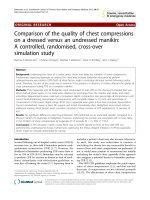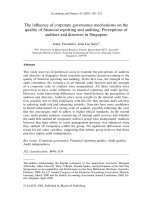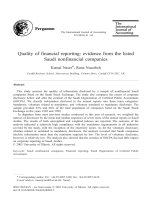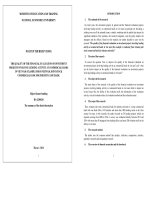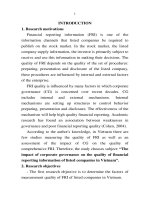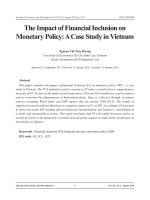unlicensed the influence the quality of financial reporting on firm value (survey on banks listed at IDX)
Bạn đang xem bản rút gọn của tài liệu. Xem và tải ngay bản đầy đủ của tài liệu tại đây (232.14 KB, 10 trang )
The Influence the Quality of Financial Reporting
on Firm Value
(Survey on Banks Listed at IDX)
Usdi Suryana
STIE Ekuitas, Indonesia
Abstract
This study aims to examine the effect of the quality of financial reporting on corporate value.
This study uses explanatory research method, data collection using census approach by distributing
questionnaires to 31 banks listed in Indonesia Stock Exchange. The unit of analysis is a bank listed on the
Indonesia Stock Exchange with internal audit manager respondents and financial accounting managers. The
type of data used is the primary data of questionnaire responses responded by respondents and secondary
data obtained from the bank's annual report. Validity test and reliability test conducted to the responses of
questionnaires collected for subsequent hypothesis testing. Analysis of hypothesis testing data using path
analysis.
The results showed that there is influence of financial reporting quality to firm value. The value of the
company will be higher if the quality of financial reporting prepared and presented meet the basic concepts,
qualitative characteristics of financial statements, recognition and measurement of financial statements.
Keywords: financial reporting quality and company value.
Chapter I: Preliminary
1.1. Background Research.
The financial statements serve as the primary tool for corporate management to deliver financial and
operational information as management accountability and to meet the needs of internal and external parties
who lack the authority to obtain the information they need for economic decision-making (Schipper and
Vincent, 2003). The same is stated in the basic framework for the preparation and presentation of financial
statements (IAI, 1994) that the purpose of financial statements is to provide information pertaining to the
financial position, performance, and changes in the financial position of an entity beneficial to a large number
of users in economic decision-making. One of the information that most concerns the user on the financial
statements is the information about the firm's earnings, since profits represent the overall performance of the
company. The concept of profit in the semantic level includes the meaning of profit as a performance gauge,
confirmation of investor expectations, and economic profit estimator. Although accounting should not be able
to measure and present economic profit, accounting should at least provide profit information that can be used
by users to measure economic profit which in turn to determine the economic value of the company
(Suwardjono, 2008).
The Bank as a trust institution shall prepare and present the financial statements as a form of management
accountability to stakeholders for the trust it has received (PBI, 2008). In recent years, the financial statements
of public companies in Indonesia have always been in the spotlight of interested parties. Indonesia Stock
Exchange (BEI) in 2012 noted there are 54 issuers late deliver the financial statements of the audit results in
2011 that must be reported in 2012. According to the Director of Corporate Valuation BEI, Hoesen, in BEI,
Jakarta, some violations of issuers associated with financial statements are still frequent occurs in addition to
delays in the delivery of financial statements, other violations of incomplete financial statement components,
late submission of audit plans or limited review of financial statements. Several other violations are the
number of reports that are not in accordance with the explanation in the note, the information in the financial
statements in the form of softcopy is not the same as the hardcopy financial statements announced in the mass
media, the figures in the financial statements that can not be proved or subsequent explanation of the event is
not adequate Merdeka.com, 13/08/2012).
Similarly, the case of revision of the financial report of Bank Bukopin resulting in a decline in profits from
Rp. 1 trillion to 183 billion due to errors in the recording of interest income from credit cards (Kontan
18/5/2018.
In Indonesia a bit more happened is not yet done the Standard Operations and Procedures (SOP) and
internal controls well, in addition to the lack of supervision from top leaders also although it has been
implemented not infrequently procedures that are common and simple it is often found not conducted
regularly.
Based on the above phenomenon and in an effort to implement governanace for commercial banks in
delivering financial information through quality financial reporting, Bank Indonesia in accordance with PBI
number 8/14 / PBI / 2006 has obliged the Commercial Bank to establish an audit committee. The occurrence
of a financial scandal is a failure of supervisory institutions, namely audit committee and internal audit in
performing its role of producing financial reports that have high integrity and reliable to meet the information
needs of users of the report (Nashwa George, 2003). Profit as part of the financial statements does not present
the actual facts about the economic condition of the company so that the expected profit can provide
information to support decision making into questionable quality. Financial performance that does not
indicate actual information about management performance may mislead the users of the report. (Schipper
and Vincent: 2003).
In a capital market environment, published financial statements are an important source of information
that most financial users and / or market participants and stakeholders need to support decision-making.
From some of the information obtained in the financial statements, profit becomes the center of attention of
the users (Beattie et al., 1994). The published earnings may respond varied, indicating a market reaction to
earnings information (Cho and Jung, 1991). The reactions given depend on the quality of profits generated by
the
company.
As a public company whose shares are owned by the public through the stock exchange, the presentation of
financial statements must meet the requirements stipulated by the competent authority, in Indonesia this
institution is the Financial Services Authority / OJK and this report must be published through mass media
which can be used as important sources of information required by shareholders in particular and
stakeholders in the company (stakeholders) in general. One of the regulations is that issuers are required to
disclose important information through annual reports including financial reports to shareholders and other
reports to OJKs, Stock Exchanges, and to the public in a timely, accurate, understandable and objective
manner. (Bapepam LK, 2011).
Based on the situation, the conditions and phenomena that have been mentioned above, and supported by
some survey results that have been done before, it can be formulated the theme of this research as follows:
"That if the quality of financial reporting is good then the probability of firm value will be affected". Based
on the theme of the study the authors are interested to conduct research with the title "The Influence of Quality
of Financial Reporting to Company Value". This research will be conducted on Banking companies listed in
Indonesia Stock Exchange (BEI).
1.4. Usefulness of Research Results.
1.4.1. Usefulness or Practical Use.
The results of this study are expected to contribute ideas and solutions to problem solving; Public bank,
the results of this study provide input on the implementation of the preparation, presentation of financial
reporting in accordance with the applicable financial accounting standards consistency.
1.4.2. Usefulness in Science Development.
The results of this study are expected to contribute in the development of financial accounting studies, as
follows;
For the academic world, make a scientific contribution based on the results of empirical evidence conducted
so as to support or complement the theories of the results of existing research related to accounting science,
especially financial accounting.
The results of this study are expected to be used for further investigators with topics that are still relevant
both complementary and continue similar research in the future.
Chapter II: Literature review.
2.1. Quality of Financial Reporting.
Companies that have a good reputation for financial reporting will be able to increase their capital.
Moreover, an argument that with such financial reporting will also get lower capital costs because the
company will reduce the issue when the company reports it more fully and reliably. (Harry I Wolk et al., 1989).
FSAB in Suwardjono (2008-157) The main purpose of financial reporting is to provide information about
the economic resources of a business entity, claims against those resources (the obligation of a business entity
to transfer economic resources to another entity and owner's equity) and the consequences of transactions,
events and circumstances that alter the resources of the enterprise and claims against those resources. A large
number of new economic activities require additional capital resources. Companies can accumulate the
amount of capital needed to be met at a greater cost in the framework of industrialization. It encourages the
separation of management with owners so that management becomes more specific. A new accountability is
established between management and owners and is supported by regulation to facilitate corporate
development and protection of all matters relating to the organization of the company, especially the owner /
shareholder as a provider of capital. The accountability has been satisfied by providing information by the
management of the company to the shareholders as outlined in the annual report of which most of the contents
of the financial statements (Michael Gaffikin, 2008)
The Ross L Watss & Zuo Luo 2011 study proves that accounting conservatism affects the value of firms
during the crisis of 2008, indicating that firms with more conservative accounting policies in financial
reporting during the crisis period were significantly reduced. Kristen L.Andersen and Teri Lombardi Yohn
(2009) in his research examined the effect of restatement of financial statements and the disclosure of income
recognition problems to market reaction. The result of his research shows that there is a negative market
reaction to the announcement of the accounting problem. The same thing shows that companies announcing
the restatement of financial statements relating to income recognition issues show a greater negative reaction.
The results of Zaenal Fanani's (2009) study stated that the quality of financial reporting with the attributes of
relevance, timelines and conservatism has significant economic consequences relationship with the value of
shares as the impact of information asymmetry. Nevertheless, Abubakar Salisu's (2008) research findings
indicate that accounting information of listed companies in the Nigerian stock exchange has little significant
relevance value for users of information in making investment decisions.
2.2. Paradigm of research,
2.3. Hypothesis
In accordance with the framework that has been described previously, it can be formulated research
hypotheses. The hypothesis formulation is
H1 The quality of financial reporting affects the value of the company
Chapter III: Research methods.
3.1. Objects and Methods.
The object of research in this study is the quality of financial reporting and corporate value. The focus of
research is directed to the quality of financial reporting both weaknesses and advantages in increasing the
value of the company.
The research method used in this research is explanatory research (expalanatory reserach), because it is a
research that explains the causal relationship between variables (Cooper and Schindler, 2006: 154) through
census research.
3.2. Variable Operationalization.
1. Quality of financial reporting.
The main purpose of the financial reporting process is to provide high quality financial reports that present
information on economic entities, the main financial conditions for use in economic decision making (IAI,
2012). Providing high quality financial reporting information is important because it positively affects capital
providers and other interested parties in making investment, credit and allocation decisions that can improve
market efficiency (IASB, 2008). Subsequently financial reporting quality is operationalized in the form of
variable (X).
2. Corporate value.
According to Fama (1978), the value of a company is a reflection of its share price. The market price of a
company's stock formed between the buyer and the seller in the event of a transaction is called the market
value of the firm, since the stock market price is considered a reflection of the true asset value of the firm. The
value of a firm formed through an indicator of the market value of the stock is heavily influenced by
investment opportunities. The existence of investment opportunities can provide a positive signal about future
company growth, so that will increase the stock price, with rising stock prices then the value of the company
will increase. Furthermore the concept of corporate value is operationalized in the form of variables (Y).
As a further elaboration of the operationalization of variables, in Table 3.1. presented measurement of
observed variables consisting of variable elements, the concept of variables / dimensions, indicators and
measurement scale.
Table 3.1. Operationalization Variable
Variable
Financial
Reporting
Quality
(X)
SFAC,
Harry Wolk, at al, 2003
Ahmed R
Belkaoui, 2006
Suwardjono, 2008
IAI, SAK, Revisi 2009
Corporate Value
(Y)
Tobin, 2001
W.Brigham, 2003
Jonathan Berk, 2007
Dimension
1.Basic Concept
2.Qualitative
characteristics
of
financial statement
Indicator
Accrual basic
Going concerns
Understandable
Relevant
Reliability
Comparable
3.Recognition
of
elements of financial
statament
4. measurement of
elements of financial
statement
Share holder value
Stock price/
Nominal value of the share
Scall
Ordinal
Ordinal
Ordinal
Ordinal
Ordinal
Ordinal
Item
1
2
3-4
5, 6,7
8-11
12-14
Ordinal
15
Ordinal
16
Rasio
Source: data is processed from various sources
3.3. Data types, Research instruments and Measuring Instruments.
Type of data in this research is primary data and secondary data. Primary data is used to measure the
quality of financial reporting and secondary data used to measure company value. To obtain the data the
instrument used in this study is a questionnaire to obtain data quality reporting financial variables and make
an analysis to examine existing data and information for corporate value variables. In this study the party who
will answer the proposed instrument item / respondent is the Financial Accounting Manager at the Bank
listed on the Indonesia Stock Exchange. For secondary data with data source obtained from daily data of share
price at Indonesia Stock Exchange and annual report and financial report of Bank registered in Bursa Efek
Indonesia.
The research measuring instrument used in this study, to change the qualitative data from the
questionnaire into a quantitative data size is Summated Rating Method: Likert Schale (Likert Scale). With
Likert scale, the variables measured as starting points to arrange the items of the instrument in the form of
statements or questions scored in seven levels, moving from 1 to 7
3.4. Population Research and Census.
The target population in this study were all bank companies listed on the Indonesia Stock Exchange in the
year 2017, namely: (i) a banking service provider company during the period of observation (ii) companies
issuing annual reports for the year ended 31 December 2015, 2016 and 2017. The number of banks listed on
the Indonesia Stock Exchange up to 2017 is 31 Banks.5 In this study, the respondents are audit committee,
internal supervisory unit and manager of Financial Accounting Division at a bank company listed in Indonesia
Stock Exchange.
3.5. Data Analysis Tool.
Method of data analysis is by way to describe data according to the elements contained in each variable.
Data analysis here the main purpose is to test the research hypothesis. The data analysis tool used is path
analysis.
3.6. Flow Chart Development (path diagram)
The flow diagram will make it easier to see causal relationships normally expressed in terms of equations.
The theoretical basis for explaining relationships among variables has been described as in the framework of
thought. The path diagram or research model to be tested is as follows:
Figure 3.1.
Line Chart Model
3.7. Hypothesis Testing Research
1) Partial Testing.
t1 =
To test the
Decision Criteria:
hypothesis
formulation
above
used
t
test
with
the
formula,
as
follows:
Not accepted Ho if thitung> t (0,05) (n-k-1)
Accept Ho if thitung ≤ t (0.05) (n-k-1)
Chapter IV: Research Result And Discussion.
4.1 Research Results.
4.1.1. Deskripsi Return Rate Questionnaire.
Distribution and collection of questionnaires was conducted for three months from December 2017 to
March 2018. Questionnaires were given to 31 Banks, each Bank was given 3 questionnaires to be addressed by
the Chair / Member of the Audit Committee, Internal Audit Manager and Finance Manager with the number
of questionnaires distributed 93 questionnaires. Of the 93 questionnaires distributed, the number of returned
questionnaires was obtained from 31 units of public bank analysis in Indonesia or 100%, with a total of 68
questionnaires from 93 submitted questionnaires or 73.12%.
The rate of return of the questionnaire according to Cooper and Schindler (2006: 314), the rate of return of
30% is good, and it would be better if it reached 70%. Thus, the return of the questionnaire of 73.12% is a good
rate of return based on the criteria proposed by Cooper and Schindler (2006: 314).
4.1.2. Views of Observation Unit.
The observation unit in this study is a public bank that has audit committee, internal audit, performing
financial reporting and selling shares in capital market. Respondents in this study are the Chairman /
members of the Audit Committee, Internal Audit Unit Manager and Financial Accounting Manager as
responsible persons in their respective fields / departments to respond to the statements described in the
questionnaire to measure the role of the audit committee, internal audit and financial reporting quality.
Information on the value of the company in the observation unit of the Bank recorded in Indonesia, for the
price of shares obtained from the source of the Indonesia Stock Exchange in 2015, 2016 and 2017.
4.1.3. Test Results Validity and Reliability Research Data.
Testing the validity using product moment correlation (index validity) where the statement is declared
valid if the correlation coefficient item statement 0.30. Then reliability testing using split-half method
of Spearman Brown and the results are stated reliably if the reliability coefficient greater than 0.70. Based on
the results of testing data obtained through the spread of questionnaires entirely valid and reliable.
4.2. Testing.
4.2.1. Testing The Effect Of Quality Of Financial Reporting To Company Value
The hypothesis to be tested is the effect of the quality of financial reporting on company value. Based on
the results of data processing obtained coefficient path from the quality of financial reporting to corporate
value can be seen in the table below.
Variable
Y
Path Coeficient
0.488
tcount
3.009
R2 = 0.238
Threshold Coefficient of T count R2 = 0.238
Source: Result by data
From the table above obtained the total influence of financial reporting quality variable (X) to the value (Y) is
0.238 or 23.80%. While the rest of 76.20% is the influence of other factors beyond the quality of financial
reporting. Visually, the path diagram of the influence of financial reporting quality on company value is shown
in the following figure:
Line Chart On Hypothesis Fourth Testing
1.000 – X ---- 0.488
Y 0.762
Through the values contained in the picture above can be calculated the influence of independent variables
(financial reporting quality) to the value of the company.
Y = 0.488 * X
After the path coefficient is calculated, furthermore to prove whether the quality of financial reporting
significantly influence the value of the company, then tested the following hypotheses:
Hypothesis:
H0: ρyx = 0
H1: ρyx ≠ 0
The quality of financial reporting does not affect the value of the company.
The quality of financial reporting affects the company's value
Coefficient of Financial Reporting Quality Path
Against Company Value
Coefficient path
tcount
ttable (db:29)
H0
H1
0.488
3.009
2.045
Not accept
Accept
Result of Testing Influence of Quality of Financial Reporting
Against Company Value
Based on the test results in the table above can be seen t count value of financial reporting quality variables
of 3.009 and t table of 2.045 where the value t count = 3.009> t table = 2.045. Since the value of t count is greater
than t table, with α = 5% it is decided not to be received H0 so that H1 is accepted.
So based on the test results can be concluded that the quality of financial reporting has a significant positive
effect on the value of the company. The results of this test provide empirical evidence that the better / higher
the quality of financial reporting will increase the value of the company.
4.3. Discussion
After the hypothesis test results are statistically, then in this section will be a descriptive discussion that
explains the results of empirical tests compared with the theory put forward in the literature review
(CHAPTER II) and the results of previous research.
4.3.1. The Effect of Quality of Financial Reporting on Company Value.
The result of hypothesis testing shows that the quality of financial reporting has an effect on the value of
the company Public Banks in Indonesia is 23.80%. The magnitude of influence of 23.80%, according to the
Guilford category, the quality of financial reporting has a weak influence on corporate value. Strong weak
influence refers to Guilford's opinion (1956), which determines that the magnitude of the interval 0.20 - 0.39 is
in the weak classification. The calculation of the condition of the value of public bank companies in Indonesia
with the parameters of the value of shares in the ratio of price to book value in the last three years both the
value of the ratio and growth mostly in the category of less good value.
The value of public bank companies in Indonesia for the value of the stock range is very wide ranging from
the low of 0.427 and the highest of 102,667. The share price of the public bank is still relatively weak with only
9 entities with two-digit ratios (above 10) and 22 entities below 10, even 3 entities with ratios below 1. This
indicates that fundamental conditions that can increase the value of shares still need to be improved.
The quality of financial reporting of public banks in Indonesia shows the grand mean of 6.38 is at 6-7
intervals (very good). Although in some cases still needs to be improved as in the application of accrual and
cash basis principles for revenue recognition is still not consistent, the presentation of market variant
information as a feedback material for users of financial statements is still incomplete, the presentation of
information in outline about the bank's annual yields both positive and negative has not been clearly disclosed.
There are still some weaknesses in the financial reporting process of public banks in Indonesia that is related
to the consistency of the implementation of accrual basis and cash basis as the basis of measurement and
recognition of income, the process of auditing financial statements by the Public Accounting Firm that still
takes relatively more than 2 months after the end of the book year to produce the financial statements of audit
results, so that the publication of audited financial statements of the bank to lose momentum to meet the needs
of investors. The relative audit process takes time considering the complexity and many transactions and fully
electronic data processing that makes public accountants more cautious before expressed their opinion on the
financial statements.
The value of the firm is the perception of investors to the company often associated with stock prices. High
stock prices make the company's value high and commonly indicated by price to book value. High corporate
value is very important because with high corporate value will be followed by high shareholder wealth, the
higher the stock price the higher the value of the company (Brigham: 1996).
The results of this study are consistent with the results of research conducted by Michael Gaffikin (2008),
Mingzhi (2011), Ross et.al (2011) with results showing empirical evidence that, there is a significant positive
effect of financial reporting quality on stock returns, reduce the low level of investment and increase the value
of the company.
From result of hypothesis test show that there is positive influence of financial reporting quality to public
bank company value in Indonesia equal to 23,80% while the rest equal to 76,20% influenced by other factors
like ownership, governance process, management integrity, condition of capital market and macro economy
overall (Fama, 1978; Gerald White, 2010; Korajzyck & Levy, 2003; Kakani Ram et.al., 2001).
Chapter V: Conclusions And Suggestions.
5.1 Conclusion.
Based on the formulation of the problem, the formulation of hypotheses and research results, it can be
concluded as follows:
1. The quality of financial reporting affects the value of the company, although the quality of financial
reporting generated by the bank still needs to be improved in terms of: consistency of implementation of
accrual basis and cash for recognition and measurement of income, process and completion of financial
statement audit by public accountant which is still late.
5.2 Suggestions
5.2.1 Operational Suggestions
1. Improving the quality of bank financial reporting by applying consistently the applicable financial
accounting standards, in particular the application of the accrual and cash basis principles for recognition and
measurement of revenue supported by adequate accounting information system technology.
2. Accelerate the audit process of financial statements by public accountants by preparing early the process
of selecting a public accounting firm that will audit financial statements. It should be included in the audit
committee's annual work program.
5.2.2 Science Development Advice.
1. In connection with the development of accounting science, especially financial accounting, internal audit,
and governance, this study has proven that the role of audit committee and internal audit has an influence on
the quality of financial reporting. For the next researcher can include other variables that can improve the
quality of financial reporting, such as risk management, and independent commissioner, which is not writer
enter as research variable.
2. This research has not revealed the influence of the quality of financial reporting to the value of the
company as a whole, then for further research can examine other variables of financial reporting quality such
as risk accounting, and discretionary election of accounting policy.
Reference
Abubakar Salisu. 2011. Value Relevance of Accounting Information of Listed new economy Firms in Nigeria: An empirical Investigation
using Ohlson Model. Journal of Management and Enterprises Development. Nigeria
Arnold Schneider.1999. A Test of Audit different to Financial Reporting Irregularity Using the Randomized Response Technique, The
Accounting Review, American Accounting Association
Bank Indonesia Regulation number 116 / PBI / 1999 on Assignment of Compliance Director and Standard of Implementation of Bank
Internal Audit Function.
Bank Indonesia Regulation Number 8/4 / PBI / 2006 concerning Implementation of Good Corporate Governance for Commercial Banks.
Beattie, V., S. Brown, D. Ewers, B. John, S. Manson, D. Thomas and M. Turner, 1994. Extraordinary Items and Income Smoothing:
Appositive Accounting Approach, Journal of Business Finance and Accounting, 21 ( 6), September, p. 791-811.
Carcello, J. V., and T. L. Neal. 2002. Disclosure in audit committee characteristics report. Accounting Horizon 16 (4): 291-304.
Kontan, Laporan Keuangan Bank Bukopin, 2018.
Cho and Jung, 1991, Valuation implications of Reliability Differences: The Case of Non pension Postretirement Obligations, The
Accounting Review 72 (3): 351-383.
Decree of Chairman of Bapepam no. Kep. 29 / PM / 2004. Concerning Establishment and Guidelines for the implementation of the Audit
Committee Work
Fama and Jensen. 1988, Common Risk Factors in the Return of Stocks and Bonds, Financial Economic, 33 (1), 3-56.
Gaffikin, Michael John Renny. 2008. Accounting Theory Research, regulation and accounting practice, Pearson Education Australia,
French Forest NSW.
IASB. 2001 Conceptual framework for Financial Reporting: The Objective of Financial Reporting and Qualitative Characteristics of
Decision-useful Financial Reporting Information. London.
Indonesian Institute of Accountants (IAI), 2012. Statement of Indonesian Accounting Standards, Revised 2009. IAI.
Krishnan, Jayanthi, 2005. Audit committee quality and internal control: And empirical analysis. The accounting review. 80, (2). 649-675.
Mingzhi LIU, 2011. Financial Reporting Quality and Corporate Bon Markets, Journal of Economic Financial, Concordia University
Montreal, Quebec, Canada
Moeller Robert R, 2004. Sarbanes Oxley and the New Internal Auditing Rules, John Willey & Sons, Inc., Hoboken, New Jersey.
Moeller Robert R, 2009. Brink Modern Internal Auditing, Seventh Edition, John Willey & Sons, Inc., Hoboken, New Jersey.
Schipper,
K.
and
Vincent,
2003.
Earning
Quality,
Accounting
Horizons
(Supplement),
97110.
Soewardjono, 2008. Accounting Theory of Engineering Financial Reporting, Third Edition. The third printing, BPFE Jogjakarta.
Wolk, Harry I Michael G Tearney, and James L. Dood, 2003, Accounting Theory A Conceptual and Institutional Approach, Fifth Edition,
South Western College Publishing.
Zaenal Fanani. 2009. Quality of Financial Reporting, Various Determinants and Economic Consequences, Journal of Accounting and
Finance Indonesia, Volume 6 No.1 page 20-45.
